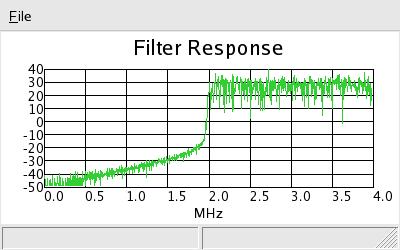FIR Filter
Modules:
- gr.fir_filter_IOT
- gr.firdes.TYPE
where, for gr.fir_filter_IOT, I and O can be any of c (complex), f (float) and s (short) for input
and output data type, and T can be c (complex) or f (float) for the filter
taps. gr.fir_filter_IOT takes two parameters, for example:
gr.fir_filter_fff ( \
int decimation,
vector<float> taps )
for float in, float out with float taps.
Valid filter TYPEs are
- gr.firdes.low_pass
- gr.firdes.high_pass
- gr.firdes.band_pass
- gr.firdes.band_reject
- gr.firdes.hilbert
- gr.firdes.root_raised_cosine
- gr.firdes.gaussian
The parameters for each filter type are:
gr.firdes.low_pass ( \
double gain,
double sampling_freq,
double cutoff_freq, // Hz center of transition band
double transition_width, // Hz width of transition band
win_type WINDOW )
Note that transition_width determins the number of taps required. Narrow widths
require more taps, and hence more CPU usage.
WINDOW determins maximum attenuation and passband ripple, and can be any of
- gr.firdes.WIN_HAMMING
- gr.firdes.WIN_HANN
- gr.firdes.WIN_BLACKMAN
- gr.firdes.WIN_RECTANGULAR
gr.firdes.high_pass ( \
double gain,
double sampling_freq,
double cutoff_freq, // Hz center of transition band
double transition_width, // Hz width of transition band
win_type WINDOW )
gr.firdes.band_pass ( \
double gain,
double sampling_freq,
double low_cutoff_freq, // Hz center of low transition band
double high_cutoff_freq, // Hz center of high transition band
double transition_width, // Hz width of transition bands
win_type WINDOW )
gr.firdes.band_reject ( \
double gain,
double sampling_freq,
double low_cutoff_freq, // Hz width of low transition band
double high_cutoff_freq, // Hz width of high transitin band
double transition_width, // Hz width of transition bands
win_type WINDOW )
gr.firdes.hilbert ( \
int ntaps, // Number of taps, must be ODD
win_type WINDOW )
gr.firdes.root_raised_cosine ( \
double gain,
double sampling_freq,
double symbol_rate // Symbol rate, NOT bitrate (unless BPSK)
double alpha // Excess Bandwidth Factor
int ntaps )
gr.firdes.gaussian ( \
double gain,
double sampling_freq,
double symbol_rate,
double bt, // Bandwidth to bitrate ratio
int ntaps )
Example usage:
First compute the filter taps for, say, a high_pass filter to reject
everything below 2Mhz with a 100Khz wide skirt:
sampling_rate = 8.6
hpf = gr.firdes.high_pass ( 1.0, sampling_rate, 2e6, 100e3, \
gr.firdes.WIN_HAMMING )
Now create the filter and we'll use a noise source to see how it looks:
signal = gr.noise_source_f (gr.GR_GAUSSIAN, 1, 2829)
filter = gr.fir_filter_fff ( 1, hpf )
which give a response like this:

Complete script: high_pass_rf_filter.py
See the experiment Filtered Noise for a band_pass example.
